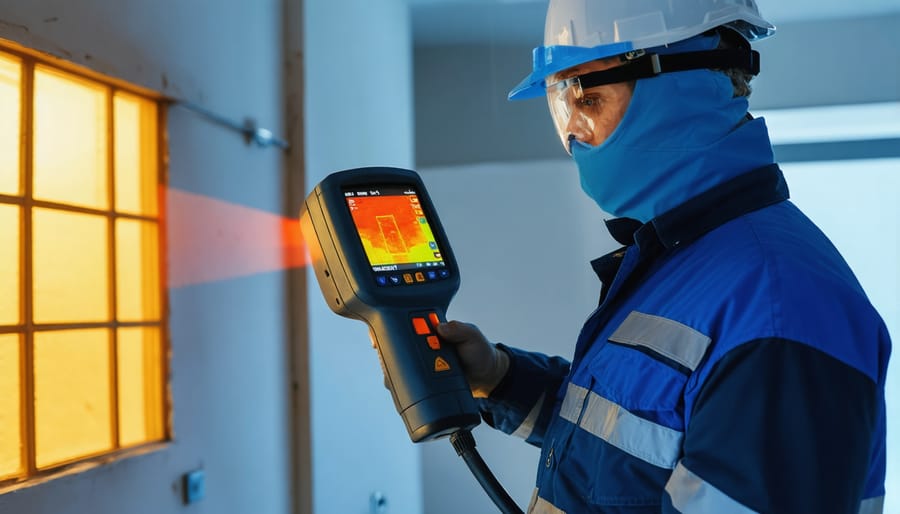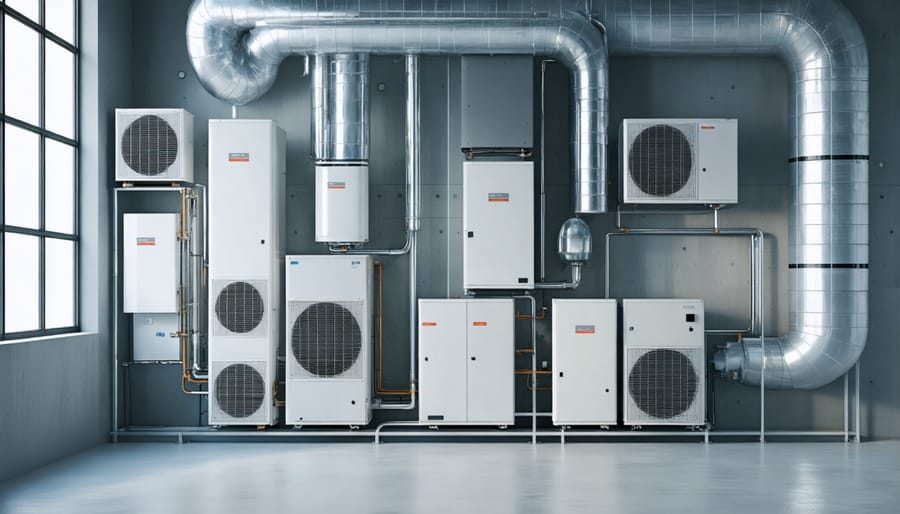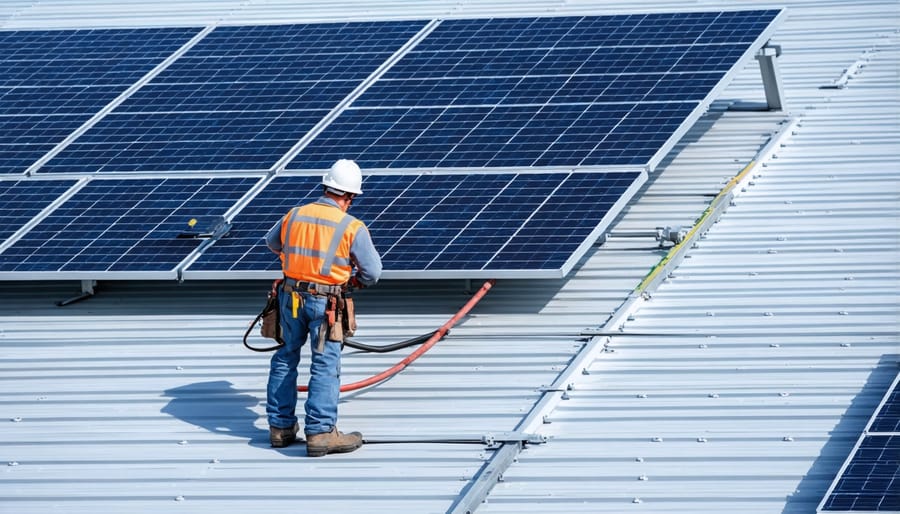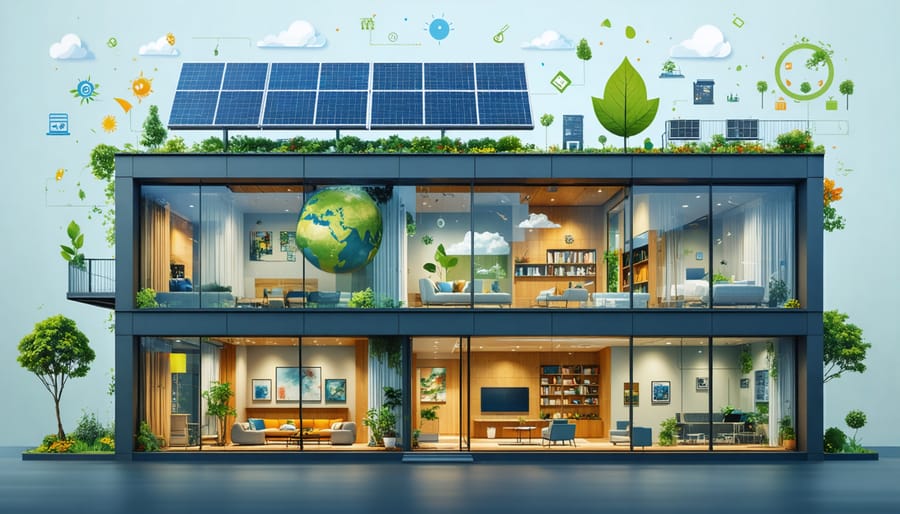Slash energy costs and boost efficiency with these powerful retrofit secrets:
Unlock massive potential savings by targeting the building envelope first. Air seal gaps, add insulation, and upgrade to high-performance windows.
Optimize HVAC systems with smart thermostats, regular maintenance, and high-efficiency equipment upgrades. Rightsize units for peak performance.
Harness passive strategies like daylighting, shading, and natural ventilation to minimize mechanical system loads. Integrate these elements seamlessly into the building design.
Assessing Your Building’s Energy Efficiency
DIY Energy Audits
Building owners can conduct low-cost energy audits to identify inefficiencies and prioritize upgrades. Start by collecting utility bills and tracking consumption patterns. Walk through the building, noting areas of energy waste like drafty windows, outdated lighting, or equipment left running unnecessarily. Use a thermal camera or smoke pencil to detect air leaks around doors, windows, and penetrations. Check insulation levels in walls, attics, and ducts. Monitor temperature settings on thermostats and hot water heaters. Assess the age and condition of major appliances and equipment. Simple tools like watt meters can measure plug loads from electronics and appliances. Keep a log of findings to guide retrofit decisions and track progress over time. While professional audits provide more comprehensive analysis, these DIY methods offer a low-cost starting point for improving building efficiency.
Professional Energy Assessments
Hiring a certified energy auditor for a professional energy assessment offers numerous benefits when planning a building retrofit. An experienced auditor will conduct a thorough analysis of your building’s current energy performance, identifying inefficiencies and potential improvement areas. They utilize advanced diagnostic tools like thermal imaging and blower door tests to uncover hidden issues such as air leaks, insulation gaps, and HVAC system imbalances. Based on their findings, energy auditors provide a detailed report outlining cost-effective retrofit recommendations tailored to your building’s unique characteristics. This comprehensive roadmap prioritizes upgrades based on energy savings potential, ROI, and alignment with your budget and sustainability goals. By investing in a professional energy assessment, building owners and managers can make informed decisions, optimize retrofit plans, and maximize long-term energy savings. Industry experts recommend conducting assessments every few years to stay current with evolving technologies and maintain peak efficiency performance.

High-Impact HVAC Retrofits
Smart HVAC Controls
Smart HVAC controls, such as wifi thermostats and automated zoning systems, can significantly improve a building’s energy efficiency by optimizing heating and cooling. Wifi thermostats allow for remote monitoring and control of temperature settings, enabling facility managers to adjust settings based on occupancy and usage patterns. This can prevent energy waste from heating or cooling unoccupied spaces. Automated zoning takes this a step further by dividing the building into separate zones with independent temperature control. Each zone’s temperature is regulated based on factors like occupancy, time of day, and outside weather conditions. By delivering targeted heating and cooling only where and when it’s needed, automated zoning minimizes energy consumption without sacrificing occupant comfort. Retrofitting an existing building with smart HVAC controls can yield substantial energy savings, often with a relatively short payback period. When combined with other efficiency measures, these intelligent systems contribute to a more sustainable and cost-effective building operation.

High-Efficiency HVAC Equipment
High-efficiency HVAC equipment is a cornerstone of any comprehensive building energy retrofit strategy. Upgrading to variable-speed air conditioning systems can significantly reduce energy consumption by allowing the compressor to adjust its speed based on cooling demands. These smart systems operate at lower speeds most of the time, resulting in less energy waste and improved temperature control. Heat pumps are another powerful energy-saving option, capable of providing both heating and cooling while consuming less energy than traditional furnaces and air conditioners. By moving heat rather than generating it, heat pumps can achieve efficiencies of up to 300%. For even greater savings, consider geothermal heat pumps that harness the stable temperatures beneath the earth’s surface to heat and cool buildings with minimal energy input. While the upfront costs may be higher, the long-term energy savings and reduced maintenance needs make these systems an attractive choice for many commercial buildings. When combined with proper sizing, zoning, and smart controls, high-efficiency HVAC retrofits can slash energy bills by 20-50% while improving occupant comfort and indoor air quality. As with any major retrofit, it’s crucial to work with experienced professionals who can assess your building’s unique needs and recommend the most cost-effective solutions for maximum impact.
Improving Building Envelope Efficiency
Targeting Air Leaks
Sealing air leaks is critical for improving energy efficiency in buildings. Start by identifying leaks around doors and windows using a smoke pencil or blower door test. Weatherstripping and caulking can effectively seal these openings. For walls, use expanding foam or caulk to fill gaps around penetrations like pipes, wires, and outlets. Seal larger holes with foam board insulation and joint tape. Pay special attention to the attic, sealing top plates, wiring/plumbing penetrations, and attic access hatches. Insulating and sealing HVAC ductwork is also crucial, as leaky ducts can waste significant energy. Use mastic sealant or metal tape to seal duct seams and joints, then insulate ducts in unconditioned spaces. Consider hiring a professional to conduct a comprehensive air sealing assessment and implement advanced techniques like aerosol duct sealing. By thoroughly sealing leaks, you can dramatically reduce air infiltration, improve comfort, and cut energy costs in retrofitted buildings.
Upgrading Insulation and Windows
Adding insulation to walls, attics, and floors can significantly reduce heat transfer and improve energy efficiency. Opt for materials with high R-values, such as spray foam, cellulose, or fiberglass, to maximize resistance to heat flow. Learn more about how to boost your building’s energy efficiency with R-value secrets. When selecting windows, consider low-emissivity (low-E) coatings that reflect heat while allowing light to pass through. Double or triple-paned windows with argon or krypton gas fills provide superior insulation compared to single-pane windows. Properly sealing around windows and doors with weatherstripping and caulk further prevents air leaks and drafts. For optimal results, hire experienced professionals to assess your building’s unique needs and install insulation and windows according to industry best practices and local building codes. By upgrading insulation and windows, you can create a more comfortable indoor environment while reducing energy consumption and costs.
Leveraging Efficient Lighting and Daylighting
Upgrading to LED lighting is one of the most cost-effective ways to improve energy efficiency in buildings. LEDs consume up to 90% less energy than traditional incandescent bulbs and last 25 times longer, significantly reducing maintenance costs. Additionally, LEDs emit less heat, which can help reduce cooling loads in the summer months.
Daylighting techniques, such as light shelves, skylights, and daylight sensors, can further enhance energy savings by reducing the need for artificial lighting during daytime hours. Light shelves are horizontal surfaces installed above windows that reflect sunlight deeper into the room, increasing the amount of natural light and reducing glare. Skylights bring in natural light from above, which can be especially effective in large, open spaces like warehouses or lobbies.
Daylight sensors, also known as photocells, automatically adjust the brightness of artificial lighting based on the amount of natural light available. When there is sufficient daylight, the sensors dim or turn off the lights, saving energy and extending the life of the bulbs. Studies have shown that proper daylighting can reduce lighting energy use by 50-80%, depending on the building’s location and design.
Combining efficient LED lighting with daylighting strategies creates a synergistic effect that maximizes energy savings and improves occupant comfort. By reducing the need for artificial lighting and its associated heat gain, these retrofits can also help reduce cooling loads and HVAC energy consumption. With the added benefits of improved productivity and well-being associated with natural light exposure, investing in efficient lighting and daylighting retrofits is a smart choice for any building owner looking to reduce energy costs and enhance the indoor environment.
Harnessing Renewable Energy
Retrofitting buildings for energy efficiency often involves harnessing the power of renewable energy sources. Onsite renewable generation options, such as solar photovoltaics (PV), can significantly reduce a building’s reliance on grid electricity. Solar PV systems convert sunlight into clean, emissions-free electricity, lowering energy costs and environmental impact. Solar water heating is another effective retrofit, using the sun’s energy to heat water for domestic or commercial use, reducing the load on conventional water heaters.
Small wind turbines, suitable for urban environments, can also contribute to onsite power generation. These compact systems harness wind energy to produce electricity, further diversifying a building’s renewable energy mix. Geothermal heat pumps, which use the stable underground temperature to heat and cool buildings, offer an efficient and renewable alternative to traditional HVAC systems. By incorporating these renewable energy technologies into a retrofit strategy, building owners can dramatically enhance energy efficiency, lower operating costs, and reduce their carbon footprint. Consulting with experienced professionals can help identify the most suitable renewable energy solutions for a specific building, taking into account factors such as location, climate, and energy demand profile.

Retrofitting for Plug Load Management
Reducing energy vampires like computers, printers, and vending machines is a key strategy for retrofitting buildings for energy efficiency. Even when turned off, many electronic devices continue to draw power, leading to unnecessary energy consumption and costs. One effective solution is installing smart power strips that automatically cut off power to devices when they are not in use. These strips can be programmed to turn off peripherals like monitors and speakers when the main device, such as a computer, is powered down. Another approach is using timers to automatically shut off devices during non-working hours, preventing them from drawing power overnight or on weekends. For vending machines, adding occupancy sensors ensures they only run when someone is nearby, reducing energy waste. Implementing these strategies can significantly reduce the impact of energy vampires, leading to lower energy bills and a more efficient building overall. By targeting these often-overlooked sources of energy waste, building owners and managers can take a comprehensive approach to retrofitting for maximum energy savings.
Conclusion
In conclusion, retrofitting buildings for energy efficiency is a multi-faceted process that can yield significant cost savings and environmental benefits. By addressing key areas such as HVAC systems, building envelope, lighting, renewable energy, and plug loads, building owners and managers can dramatically reduce energy consumption and greenhouse gas emissions. Conducting a thorough energy audit is the first step in identifying the most impactful retrofit opportunities for a specific building. While some measures can be implemented through simple DIY solutions, others may require the expertise of professional retrofit service providers. These experts can offer tailored recommendations, design and implement comprehensive retrofit plans, and ensure optimal performance of upgraded systems. By investing in energy efficiency retrofits, building stakeholders can not only lower operating costs but also enhance occupant comfort, increase property value, and contribute to a more sustainable built environment. With the right strategies and support, any building can unlock its full potential for energy savings.

